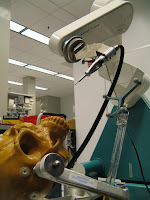NeuroSurgery Project

One of the projects of Professor Peter Kazanzides is the installation of a skull base surgery robot. They use a NeuroMate robot to assist the drilling procedures. Skull base surgery treats leisions such as acoustic neuroma, cerebral aneurys. Providing a robot-mounted drilling and milling tool this application can reduce surgical error and procedure time. They have a NeuroMate robot in Johns Hopkins Hospital, downtown Baltimore, that has a 6DOF force/torque sensor mounted above the tool. (Pictures on the setup.) The idea of the application is to integrate imaging and robot control to improve the accuracy of the surgery. First the patient goes into the CT scan, along with fiducials. These help to determine the coordinate system of the CT based 3D model. It is processed with the open-source 3D Slicer. The area of the drilling is determined on the model called virtual fixtures. During the surgery the surgeon holds the drilling instrument mounted on the robot. The robot applies counter-forces whenever the surgeon would leave the pre-define virtual fixtures. This makes the operation safer and faster. Two PhD students have been working on this robot so far: Tian Xia and Babak Matinfar.
For safety reasons, there is an additional optical tracking system, the StealthStation. It can determine the spacial position of the robot's end effector and the patient with the help of the mounted markers. The importance of the system is to give a real time feedback of the relative positions during the procedures, as it is crutial to monitor any changes to the pre-registered relative position of the robot to the patient. My role will be to improve the effectiveness of this optical tracking system. Its effectiveness has to be improved along with the robustness. From the engineering point of view, the problem is that we have a very accurate relative position measuring (from the incremental encoders of the robot) and a less precise absolute measuring from opto-tracking. We have to achieve the best results possible. We are planning to introduce Kalman filtering and other methods to reduce noise.
For safety reasons, there is an additional optical tracking system, the StealthStation. It can determine the spacial position of the robot's end effector and the patient with the help of the mounted markers. The importance of the system is to give a real time feedback of the relative positions during the procedures, as it is crutial to monitor any changes to the pre-registered relative position of the robot to the patient. My role will be to improve the effectiveness of this optical tracking system. Its effectiveness has to be improved along with the robustness. From the engineering point of view, the problem is that we have a very accurate relative position measuring (from the incremental encoders of the robot) and a less precise absolute measuring from opto-tracking. We have to achieve the best results possible. We are planning to introduce Kalman filtering and other methods to reduce noise.


Comments